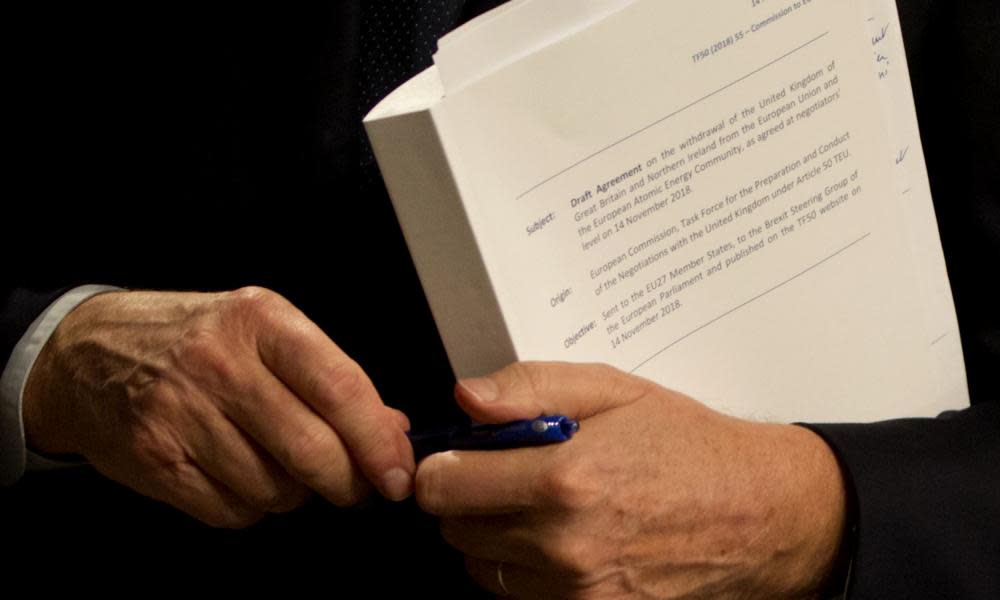Brexit deal: key points from the draft withdrawal agreement

The 585-page draft withdrawal agreement negotiated between the European Union and the United Kingdom contains several highly contentious points that supporters of Brexit in particular will find hard to stomach. Here are some of the points that may cause problems for the prime minister, Theresa May, in parliament:
Irish border backstop
The draft Brexit agreement says both parties will “use their best endeavours” to have a future trade agreement concluded six months before the end of the transition period in December 2020, but that if this is not the case the EU and the UK could “jointly extend the transition period” for an unspecified period.
Otherwise the backstop solution for Ireland and Northern Ireland aimed at preventing a hard border would come into force. The backstop, consisting of “a single customs territory between the Union and the United Kingdom”, will apply from the end of the transition period “unless and until ... a subsequent agreement becomes applicable”.
The single customs territory would cover all goods except fishery products, the agreement says, and will “include the corresponding level playing field commitments and appropriate enforcement mechanisms to ensure fair competition between the EU27 and the UK”.
There would necessarily be extra non-customs checks on some types of goods passing between Northern Ireland and the rest of the UK, which will not please the Democratic Unionist party who have consistently opposed any kind of differential treatment for Northern Ireland.
On exiting the backstop, the agreement says that if “either side considers the the backstop is no longer necessary, it can notify the other” setting out its reasons. A joint committee must then meet within six months, and both sides must agree jointly to end the backstop.
This part of the agreement would be difficult for Brexiters to swallow. They have consistently argued that Britain must be able to exit any all-UK customs union as and when it wants to be able to pursue free-trade deals around the world.
Level playing field
The agreement says that under the backstop arrangement the UK must observe “level playing field” commitments on competition and state aid, as well as employment and environment standards and tax. These measures are intended to ensure that UK businesses are not able to undercut EU industry.
Brussels has demanded “dynamic alignment”, which would oblige the UK parliament to simply cut and paste EU regulations as they are issued after Brexit. Britain must also transfer three EU tax directives into law – on the exchange of tax information, reporting on investment firms and the EU’s code of conduct on taxation.
“Non-regression clauses” will also prevent the UK from bringing in lower standards on social, environmental and labour regulations such as working hours.
Many of these requirements would also be anathema to Conservative Brexiters, for whom leaving the EU represented an opportunity to head towards a low-tax, light-regulation economy such as that seen in Singapore.
Future trade agreement
This issue may be even more depressing for Brexiters. The future UK-EU relationship, which both sides have said requires much more work but aims to achieve a close relationship on services (including financial services) and investment as well as sectoral cooperation in, for example, transport, would “build on the single customs territory provided for in the withdrawal agreement”.
Fisheries
The EU has repeatedly said that it would only allow British seafood exporters tariff- and quota-free access to EU markets in exchange for a reciprocal agreement that EU fishing fleets can continue to operate in British waters.
This potentially explosive issue appears to have been kicked down the road: the withdrawal agreement essentially says only that the EU would apply tariffs on fish until a separate agreement was struck on access to EU fishing in UK waters.
Governance
After the transition period ends, the final withdrawal agreement would be policed by a structure based on a joint committee taking decisions by mutual consent and whose verdicts would be binding.
A five-member arbitration panel would be convened to manage disputes. Any issue relating to EU law, however, cannot be decided by the arbitration panel but must go before the European court of justice. That, too, would annoy Brexiters wanting to “take back control of our laws”.
Financial Markets
In another potentially controversial clause, the draft agreement gives London’s financial centre only a basic level of access to the EU’s markets similar to that enjoyed by US and Japanese firms. It would be based on the EU’s existing system of financial market access known as equivalence – a watered-down relationship that Brussels has said all along was the best arrangement that Britain can expect.

 Yahoo News
Yahoo News 
